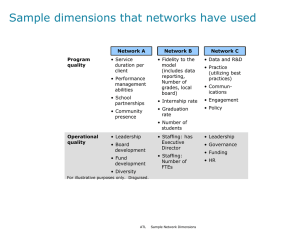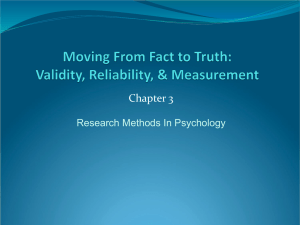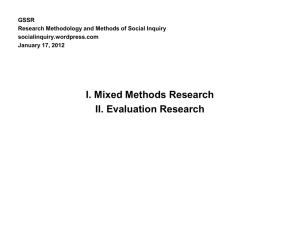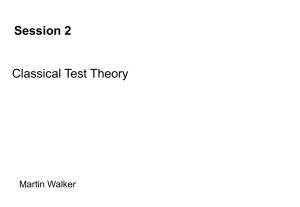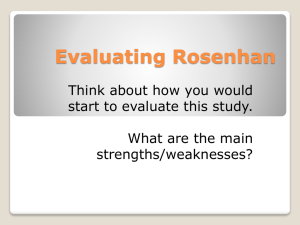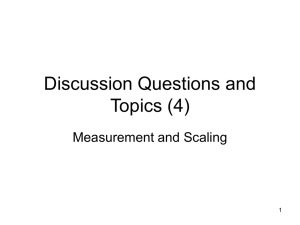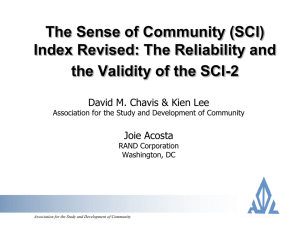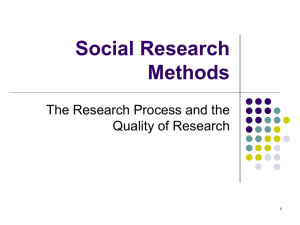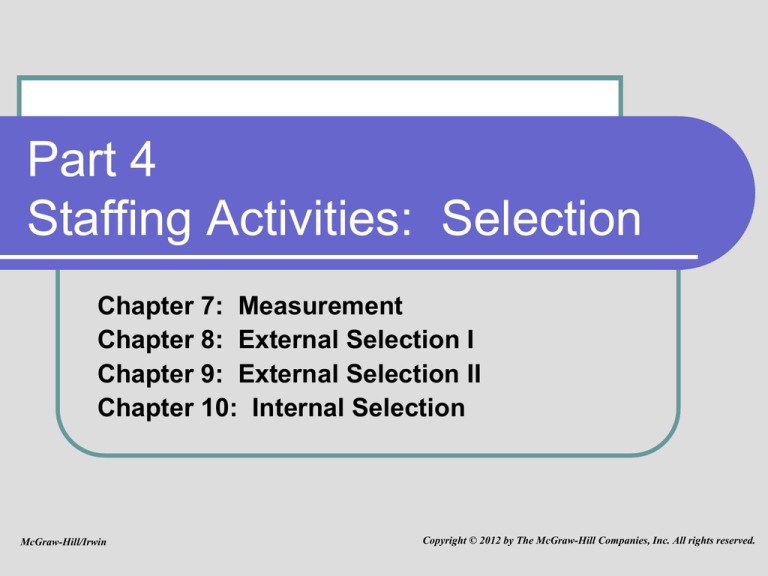
Part 4
Staffing Activities: Selection
Chapter 7: Measurement
Chapter 8: External Selection I
Chapter 9: External Selection II
Chapter 10: Internal Selection
McGraw-Hill/Irwin
Copyright © 2012 by The McGraw-Hill Companies, Inc. All rights reserved.
Part 4
Staffing Activities: Selection
Chapter 07:
Measurement
Staffing Organizations Model
Organization
Mission
Goals and Objectives
Organization Strategy
HR and Staffing Strategy
Staffing Policies and Programs
Support Activities
Core Staffing Activities
Legal compliance
Planning
Recruitment:
Selection:
External, internal
Measurement, external, internal
Job analysis
Employment:
Decision making, final match
Staffing System and Retention Management
7-3
Chapter Outline
Importance and Use of
Measures
Key Concepts
Measurement
Scores
Correlation Between
Scores
Quality of Measures
Reliability of Measures
Validity of Measures
Validation of Measures in
Staffing
Validity Generalization
Staffing Metrics and
Benchmarks
Collection of Assessment
Data
Testing Procedures
Acquisition of Tests and
Test Manuals
Professional Standards
Legal Issues
Disparate Impact
Statistics
Standardization
and Validation
7-4
Learning Objectives for This Chapter
Define measurement and understand its use
and importance in staffing decisions
Understand the concept of reliability and
review the different ways reliability of
measures can be assessed
Define validity and consider the relationship
between reliability and validity
Compare and contrast the two types of
validation studies typically conducted
Consider how validity generalization affects
and informs validation of measures in staffing
Review the primary ways assessment data
can be collected
7-5
Discussion Questions for This Chapter
Imagine and describe a staffing system for a job in which there are no
measures used.
Describe how you might go about determining scores for applicants’
responses to (a) interview questions, (b) letters of recommendation, and
(c) questions about previous work experience.
Give examples of when you would want the following for a written job
knowledge test
Assume you gave a general ability test, measuring both verbal and
computational skills, to a group of applicants for a specific job. Also
assume that because of severe hiring pressures, you hired all of the
applicants, regardless of their test scores.
a low coefficient alpha (e.g., α = .35)
a low test–retest reliability.
How would you investigate the criterion-related validity of the test?
How would you go about investigating the content validity of the test?
What information does a selection decision maker need to collect in
making staffing decisions? What are the ways in which this information
can be collected?
7-6
Key Concepts
Measurement
Scores
the process of assigning numbers to objects
to represent quantities of an attribute of the
objects
the amount of the attribute being assessed
Correlation between scores
a statistical measure of the relation between
the two sets of scores
7-7
Importance and Use of Measures
Measures
Methods or techniques for describing and
assessing attributes of objects
Examples
Tests of applicant KSAOs
Job performance ratings
of employees
Applicants’ ratings of their
preferences for various types
of job rewards
7-8
Importance and Use of Measures
(continued)
Summary of measurement process
(a) Choose an attribute of interest
(b) Develop operational definition of attribute
(c) Construct a measure of attribute as
operationally
defined
(d) Use measure to actually gauge attribute
Results of measurement process
Scores become indicators of attribute
Initial attribute and its operational definition are
transformed into a numerical expression of attribute
7-9
Measurement: Definition
Process of assigning numbers to objects
to represent quantities of an attribute of
the objects
Attribute/Construct - Knowledge of
mechanical principles
Objects - Job applicants
7-10
Ex. 7.1 Use of Measures in Staffing
7-11
Measurement: Standardization
Involves
Controlling influence of extraneous factors
on scores generated by a measure and
Ensuring scores obtained reflect the attribute
measured
Properties of a standardized measure
Content is identical for all objects measured
Administration of measure is identical for all objects
Rules for assigning numbers are clearly specified
and agreed on in advance
7-12
Measurement: Levels
Nominal
A given attribute is
categorized and numbers
are assigned to
categories
No order or level implied
among categories
Ordinal
Objects are rank-ordered
according to how much of
attribute they possess
Represents relative
differences among
objects
Interval
Objects are rank-ordered
Differences between
adjacent points on
measurement scale are
equal in terms of attribute
Ratio
Similar to interval scales equal differences
between scale points for
attribute being measured
Have a logical or absolute
zero point
7-13
Measurement: Differences in
Objective and Subjective Measures
Objective measures
Subjective measures
Rules used to assign numbers to attribute
are predetermined, communicated, and
applied
through a system
Scoring system is more elusive, often
involving a rater who assigns the numbers
Research results
7-14
Scores
Definition
Central tendency and variability
Exh. 7.2: Central Tendency and Variability:
Summary Statistics
Percentiles
Measures provide scores to represent
amount of attribute being assessed
Scores are the numerical indicator of attribute
Percentage of people scoring below an individual in
a distribution of scores
Standard scores
7-15
Discussion questions
Imagine and describe a staffing system
for a job in which there are no measures
used.
Describe how you might go about
determining scores for applicants’
responses to (a) interview questions, (b)
letters of recommendation, and (c)
questions about previous work
experience.
7-16
Correlation Between Scores
Scatter diagrams
Used to plot the joint distribution of the two sets of scores
Exh. 7.3: Scatter Diagrams and Corresponding Correlations
Correlation coefficient
Value of r summarizes both
Strength of relationship between two sets of scores and
Direction of relationship
Values can range from r = -1.0 to r = 1.0
Interpretation - Correlation between two variables does not
imply causation between them
Exh. 7.4: Calculation of Product-Movement Correlation
Coefficient
7-17
Exh. 7.3: Scatter Diagrams and
Corresponding Correlations
7-18
Exh. 7.3: Scatter Diagrams and
Corresponding Correlations
7-19
Exh. 7.3: Scatter Diagrams and
Corresponding Correlations
7-20
Significance of the Correlation
Coefficient
Practical significance
Refers to size of correlation coefficient
The greater the degree of common variation
between two variables, the more one variable
can be used to understand another variable
Statistical significance
Refers to likelihood a correlation exists in a
population, based on knowledge of the actual value
of r in a sample from that population
Significance level is expressed as p < value
Interpretation -- If p < .05, there are fewer than 5 chances
in 100 of concluding there is a relationship in the
population when, in fact, there is not
7-21
Quality of Measures
Reliability of measures
Validity of measures
Validity of measures in staffing
Validity generalization
7-22
Quality of Measures: Reliability
Definition: Consistency of measurement of an
attribute
Reliability of measurement is of concern
A measure is reliable to the extent it provides a
consistent set of scores to represent an attribute
Both within a single time period and between time
periods
For both objective and subjective measures
Exh. 7.6: Summary of Types of Reliability
7-23
Ex. 7.6: Summary of Types of
Reliability
7-24
Quality of Measures: Reliability
Measurement error
Actual score = true score + error
Deficiency error: Occurs when there is
failure
to measure some aspect of attribute
assessed
Contamination error: Represents
occurrence of unwanted or undesirable
influence on the measure and on individuals
being measured
7-25
Ex. 7.7 - Sources of Contamination
Error and Suggestions for Control
7-26
Quality of Measures: Reliability
Procedures to calculate reliability estimates
Coefficient alpha
Interrater agreement
Minimum level of interrater agreement - 75% or higher
Test-Retest reliability
Should be least .80 for a measure to have an acceptable
degree of reliability
Concerned with stability of measurement
Level of r should range between r = .50 to r = .90
Intrarater agreement
For short time intervals between measures, a fairly high
relationship is expected - r = .80 or 90%
7-27
Quality of Measures: Reliability
Implications of reliability
Standard error of measurement
Since only one score is obtained from an applicant, the
critical issue is how accurate the score is as an indicator of
an applicant’s true level of knowledge
Relationship to validity
Reliability of a measure places an upper limit on the
possible validity of a measure
A highly reliable measure is not necessarily valid
Reliability does not guarantee validity - it only makes it
possible
7-28
Quality of Measures: Validity
Definition: Degree to which a measure
truly measures the attribute it is intended
to measure
Accuracy of measurement
Exh. 7.9: Accuracy of Measurement
Accuracy of prediction
Exh. 7.10: Accuracy of Prediction
7-29
Ex. 7.9: Accuracy of Measurement
7-30
Discussion questions
Give examples of when you would want
the following for a written job knowledge
test
a low coefficient alpha (e.g., α = .35)
a low test–retest reliability.
7-31
Exh. 7.10: Accuracy of Prediction
7-32
Exh. 7.10: Accuracy of Prediction
7-33
Validity of Measures in Staffing
Importance of validity to staffing process
Predictors must be accurate representations of
KSAOs to be measured
Predictors must be accurate in predicting job
success
Validity of predictors explored through
validation studies
Two types of validation studies
Criterion-related validation
Content validation
7-34
Ex. 7.11: CriterionRelated Validation
•Criterion Measures: measures of
performance on tasks and task
dimensions
•Predictor Measure: it taps into
one or more of the KSAOs
identified in job analysis
•Predictor–Criterion Scores: must
be gathered from a sample of
current employees or job
applicants
•Predictor–Criterion Relationship:
the correlation must be
calculated.
7-35
Ex. 7.12: Concurrent and Predictive
Validation Designs
7-36
Ex. 7.12: Concurrent and Predictive
Validation Designs
7-37
Content Validation
Content validation involves
Criterion measures are not used
A judgment is made about the probable correlation
between predictors and criterion measures
Used in two situations
Demonstrating the questions/problems (predictor
scores) are a representative sample of the kinds of
situations occurring on the job
When there are too few people to form a sample for
criterion-related validation
When criterion measures are not available
Exh. 7.14: Content Validation
7-38
Validity Generalization
Degree to which validity can be extended to
other contexts
Contexts include different situations, samples of
people and time periods
Situation-specific validity vs. validity
generalization
Exh. 7.16: Hypothetical Validity Generalization
Example
Distinction is important because
Validity generalization allows greater latitude than situation
specificity
More convenient and less costly not to have to conduct a
separate validation study for every situation
7-39
Exhibit 7.16 Hypothetical Validity
Generalization Example
7-40
Discussion questions
Assume you gave a general ability test, measuring
both verbal and computational skills, to a group of
applicants for a specific job. Also assume that
because of severe hiring pressures, you hired all of
the applicants, regardless of their test scores.
How would you investigate the criterion-related validity of the
test?
How would you go about investigating the content validity of
the test?
What information does a selection decision maker
need to collect in making staffing decisions? What are
the ways in which this information can be collected?
7-41
Staffing Metrics and Benchmarks
Metrics
Staffing metrics
quantifiable measures that demonstrate the
effectiveness (or ineffectiveness) of a particular
practice or procedure
job analysis
validation
Measurement
Benchmarking as a means of developing
metrics
7-42
Collection of Assessment Data
Testing procedures
Paper and pencil measures
PC- and Web-based approaches
Applicant reactions
Acquisition of tests and test manuals
Paper and pencil measures
PC- and Web-based approaches
Professional standards
7-43
Legal Issues
Disparate impact statistics
Applicant flow statistics
Applicant stock statistics
Standardization
Lack of consistency in treatment of applicants is
a major factor contributing to discrimination
Example: Gathering different types of background information
from protected vs. non-protected groups
Example: Different evaluations of information for protected vs.
non-protected groups
Validation
If adverse impact exists, a company must either eliminate it or
justify it exists for job-related reasons (validity evidence)
7-44
Ethical Issues
Issue 1
Do individuals making staffing decisions
have an ethical responsibility to know
measurement issues? Why or why not?
Issue 2
Is it unethical for an employer to use a
selection measure that has high empirical
validity but lacks content validity? Explain.
7-45

